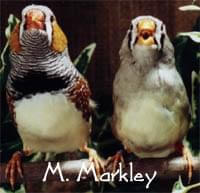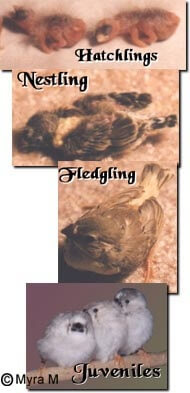Breeding Zebra Finches
..good starter finches
by Myra
Articles and Information - Lady Gouldian Finch
It has happened to people all over the world. It even happened to me. We walked into the pet store and saw those active, colorful, beeping, birds flittering about in a display cage. It was love at first sight. I knew right away I wanted to get one of these little birds but like any good bird enthusiast I did buy a basic care book before I bought my first Zebra Finch. Buying one is great, but I soon decided I would like to breed them.
Proper diet.
Zebra Finches can live just fine on finch seed mix but it is better to offer your Finches a more varied diet. I like to add millet, fresh fruits, and egg to my birds diet. Fruits like sliced apples, oranges, grapes and melons add important nutrients to the Finch diet. I also chop up hard boiled egg (shell and all) for my birds every few weeks. Fresh fruits and egg do spoil rather quickly in the open air so remove them after a few hours.
Breeding zebras are not only feeding themselves but also up to six other birds that require ever increasing amounts of food as they grow. Give the working parents extra food, a little bit of everything, and make sure they always have clean water.
Vitamin supplements added to the food or water work very well along with a balanced diet to ensure the health of your birds and their family.
A few serious health problems can be avoided with a good diet. Female Zebra Finches can become egg bound or calcium deficient if they do not get enough calcium in their diet. Both health problems can be fatal if not treated right away, consult your avian veterinarian. Various other aliments can be caused from insufficient protein, calcium, and/or vitamins.
Finding a "pair".
 Myra Markley (FinchNiche) photo of Zebra Finches
Myra Markley (FinchNiche) photo of Zebra Finches
Zebra Finches are pretty easy to sex. You can distinguish males from females by just looking at them. Male Zebra Finches have a black breast bar, chestnut flanks specked with white, orange cheek patches, a scale like pattern under the chin, and of course the red beak. Females on the other hand are totally lacking in any of the before mentioned male markings and their beaks are a lighter, more orangish color.
There are Zebra Finch color mutations that have less defined sex markings so if you really can not see any distinguishing markings on your bird, look at the beak color. In all but one Zebra Finch color mutation the beak colors will still be red or orange depending on sex.
Building a home.
Having a cage that is big enough for two birds is great if you do not plan to breed, but once you start breeding Zebras you will have to consider that soon you will not have two Zebras, you will have three to six or maybe more. Is your current cage big enough for that?
A good sized breeding cage should be around 2' L x 1'W x 18"H, but giving them even more room is even better. Zebras can breed in small cages, but I do not recommend it. They need exercise to stay fit and healthy and having a cramped cage is never good. Birds by nature fly side to side so it is a better to have a cage that is longer than it is tall.
Next the pair will need a place to raise a family. There are several types and sizes of Finch nests available. Many people use the bamboo woven nests. I use them lot because they are inexpensive and I can buy them at any pet store that sells birds. The Bamboo nests come in two sizes, regular and large. Both work great. The larger ones are best for birds that tend to have large clutches.
 Zebra Finch Nests - Breeding Supplies
Zebra Finch Nests - Breeding Supplies
Another popular nest is the wooden nest box. They can be mounted to the inside or the outside of the cage. (if mounted outside the cage, please make sure there is an opening in the cage so the birds can get to the nest box) These nests are easy to clean out and make it very easy to count eggs and check on the chicks as they grow.
People sometimes debate over what type of nesting material is best for the birds. With Zebras it is easy. If they can lift it, it will go in the nest. I like to give my Zebras small strands or burlap and shredded Kleenex to use for nesting material. It is important to make sure what you give them is not so fine that they can get it tangled around their legs or around the chicks. Bird can die if they become too entangled in material.
We have eggs!
Eggs are usually laid one a day, incubation starts after the last egg is laid, and they start hatching about thirteen days later. Zebras can lay between one and 8 eggs. Most nests have between two and five eggs though. The female does most of the incubating but the male will also take his turn on the eggs so the female can stretch, eat, and drink.
 Animated picture of the inside of a fertile egg
Animated picture of the inside of a fertile egg
If the eggs are fertile they will turn a darker color after the first week. If you can not really tell buy looking at the eggs if they are fertile or not, you can candle them. Candling eggs is really pretty simple but if you are very nervous about it, do not attempt it. To candle an egg all you need in a pen light or a small flashlight. Put the light behind the egg and look for small red veins inside the egg. You may also see the tiny embryos heart beating which will look like a small red dot, within a larger red blob, that pulsates rapidly. If the egg is a week old the entire inside may appear red, and this time you probably will not be able to distinguish the embryo.
Handling the eggs is alright if you wash your hands before hand and do not handle them a lot. The oil from human fingers can clog the tiny pours in the shell that the chick needs to get air. I try to only candle eggs once if at all. If there is room in the nest you can just put the small light in and hold it gently against the shell to look for signs of life. This method does not require that you handle the eggs at all.
Sometimes new parent birds will abandon the nest or accidentally cover the eggs with more nesting material and start over again. Removing extra nesting material as soon as the first egg is laid will help keep new parents focused on their new duties.
Baby Zebra Finches.
Hatching Zebras are about an inch in length when they hatch. Their coloring is pink with a few white downy feathers. Around three days of age they will start making an audible noise that is something like an "ff ff" sound. It is a very soft sound and some people do not always hear it until day four or five. The babies will make a little more noise with each passing day. If for some reason the parents do not feed the chicks they will die at day three when what is left of the yolk sac is used up. Some inexperienced Zebra Parents do not care for their young properly after they hatch. The pair should be allowed to rest, then try again.
 Myra Markley (FinchNiche) Photos of Zebra Finch Development
Myra Markley (FinchNiche) Photos of Zebra Finch Development
Nestling is the term used for a baby finch that is over a week old. During this phase their parents must really work hard with keeping them fed and warm as they rapidly grow. I give my zebras extra seed, milled, fruits, and egg to help the parents keep up with the chicks and stay healthy themselves.
Once they take that first bold leap from the nest they have reached Fledgling stage. The chicks are still very dependant on their parents care and feeding while they start to explore the outside world. Millet and soft foods are very important for the chicks as they learn to eat on their own. Weaning will take place a few weeks after they Fledge but the chicks will not be fully independent for another few weeks.
Independence from their parents marks the Juvenile stage. By now they will be eating on their own and soon will go through their first molt. After their first molt the sexes will be very apparent. The Males will start showing the traditional male colors as their beaks turn red. The female's beak will turn orange.
By nine months of age (sometimes younger but it's unwise to breed that young) both sexes will be ready for breeding. Males do mature earlier than females but breeding with young males does not always work well. Young males may toss eggs or chicks from the nest in the excitement to breed. If a female is mated too early she may become egg bound and die.
After the chicks are raised and on their own the parent birds may try to start the whole process over again right away. Some Zebras will continue breeding as much as possible, it is instinct and you should intervene to stop them. Rasing clutch after clutch is very hard on the parents and can severely weaken them and cause illness. After each clutch they really need a few months to rest. Removing the nest and all nesting material will stop the raising of babies but the female will continue to lay eggs.
Breeding zebras for an extra income.
This is probably not going to happen unless you have thousands of zebras and have enough people to buy all your babies. Selling babies to cover the cost of feeding the birds may work if you only have one or two breeding pairs but even then you will probably still come out behind.
I breed zebras and several of their color mutations because I enjoy the birds. I love to watch them build their nests just perfectly and raise babies. I do not mass produce Zebras, but I do breed some color mutations for exhibition in bird shows and the ones that are not of show quality I sell at fairs, to a few pet stores, and to nursing homes. Enjoy your birds.
© lady gouldian finch.com 2017